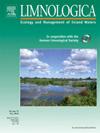Population dynamics of planktonic and symbiotic Vibrio spp. associated with the freshwater invasive snail Physa acuta (Gastropoda: Physidae) in Wouri estuary (Douala, Cameroon)
IF 2
4区 环境科学与生态学
Q2 LIMNOLOGY
引用次数: 0
Abstract
In Cameroon, the coastal city of Douala is seriously confronted with major epidemics of waterborne diseases, especially cholera, caused by pathogenic bacteria. However, the related environmental factors are poorly understood. This study aimed to investigates the population dynamics of planktonic and symbiotic Vibrio spp. associated with the freshwater invasive snail Physa acuta in Wouri estuary, focusing on the impact of selected abiotic factors. Abiotic parameters were analyzed using standardardized methods. Microbiological analyses involved isolating, identifying and counting planktonic and symbiotic Vibrio spp. cells associated with Physa acuta. The Wouri Estuary streams exhibit hypoxia, with dissolved oxygen levels as low as 1 % at certain stations and characterized by high organic matter loads. Total symbiotic Vibrio spp. abundance peaked during the rainy season and increased from freshwater saltwater gradient. The survival of both planktonic and symbiotic Vibrio spp. cells associated with Physa acuta is influenced by several abiotic factors including precipitation, salinity, suspended solids and dissolved organic matter. The species of Vibrio spp. potentially pathogen to human were isolated in both planktonic and symbiotic forms. Vibrio parahaemolyticus was provisionally identified in this study as indigenous to Physa acuta, while V. alginolyticus, V. vulnificus, V. cholerae, V. fluvialis and V. mimicus, which may be responsible for public health problems, are present accidentally in both study environments. All the evidence suggests that the bacteria present in the digestive tract of Physa acuta accumulate indiscriminately from the natural environment and constitute transient populations. Based on this study, decisions on the management of public health problems can be envisaged to avoid the emergence and re-emergence of certain zoonotic diseases.
Wouri 河口(喀麦隆杜阿拉)与淡水入侵蜗牛 Physa acuta(腹足纲:蜗牛科)相关的浮游弧菌和共生弧菌的种群动态
在喀麦隆,沿海城市杜阿拉面临着严重的水传播疾病流行问题,尤其是由病原菌引起的霍乱。然而,人们对相关的环境因素却知之甚少。本研究旨在调查 Wouri 河口与淡水入侵螺 Physa acuta 相关的浮游弧菌和共生弧菌的种群动态,重点关注选定非生物因素的影响。非生物参数采用标准化方法进行分析。微生物学分析包括分离、鉴定和计数与箭毒蜗牛相关的浮游弧菌和共生弧菌。乌里河口溪流呈现缺氧状态,某些站点的溶解氧水平低至 1%,且有机物含量较高。共生弧菌的总丰度在雨季达到峰值,并从淡水向咸水梯度增加。浮游弧菌和共生弧菌的存活受多种非生物因素的影响,包括降水、盐度、悬浮固体和溶解有机物。在浮游生物和共生生物中都分离到了对人类有潜在致病性的弧菌。在这项研究中,副溶血性弧菌被暂时确定为刺五加的本地菌,而藻类溶解弧菌、弧菌、霍乱弧菌、V. fluvialis 和 V. mimicus 等可能造成公共卫生问题的细菌则意外地出现在两种研究环境中。所有证据都表明,存在于刺葴消化道中的细菌是从自然环境中不加区分地积累起来的,构成了短暂的种群。根据这项研究,可以对公共卫生问题的管理做出决策,以避免某些人畜共患病的出现和再次出现。
本文章由计算机程序翻译,如有差异,请以英文原文为准。
求助全文
约1分钟内获得全文
求助全文
来源期刊

Limnologica
环境科学-湖沼学
CiteScore
3.70
自引率
5.90%
发文量
64
审稿时长
3 months
期刊介绍:
Limnologica is a primary journal for limnologists, aquatic ecologists, freshwater biologists, restoration ecologists and ecotoxicologists working with freshwater habitats.
 求助内容:
求助内容: 应助结果提醒方式:
应助结果提醒方式:


